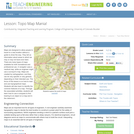
The ceremony of placing wreath on the grave of Atatürk, the father of the Turks.
- Subject:
- History
- Political Science
- Material Type:
- Primary Source
- Author:
- Gökçe Topluk
- Date Added:
- 03/10/2022

The ceremony of placing wreath on the grave of Atatürk, the father of the Turks.

In this lesson, students learn how to determine location by triangulation. We describe the process of triangulation and practice finding your location on a worksheet, in the classroom, and outdoors.

Maps are designed to allow people to travel to a new location without a guide to show the way. They tell us information about areas to which we may or may not have ever been. There are many types of maps available for both recreational and professional use. A navigator uses a nautical map, while an engineer might use a surveyor's map. Maps are created by cartographers, and they can be very specific or very general, depending on their intended use. The focus of this lesson is on how to read and use topographical maps. Students will also learn to identify the common features of a map. Through the associated activities, students will learn how to use a compass to find bearing to an object on a map and in the classroom.

This presentation explains the term myths and the other words that are commonly confused with it: history, fables, fairytales, legends, religion, and folklore. After viewing this presentation, students should have a clear grasp of what each word means and the type of narrative it describes.